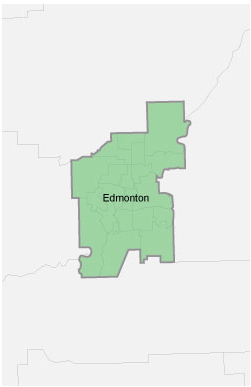Hydrovac operating specifications:
- The water pressure and temperature settings must not exceed 1,500 psi and 38°C. Any hydrovacing over these maximums can only be done on de-energized cables.
- The wand tip must be equipped with a high pressure nozzle single jet oscillating head.
- The end of the water wand and vacuum hose must have a urethane or equivalent cover to prevent mechanical damage.
- Signs indicating 'Danger' must be a minimum of 1.2 m from the job site.
The following safe work methods must be followed when hydrovacing:
- The water wand must be in a constant circular motion, avoid moving the wand parallel to the buried facility (jabbing motions are to be avoided).
- The water wand must never be left unattended with the pressure on and water flowing.
- The excavation should begin beside the locate mark(s) and go to a depth below the expected depth of the buried facility. At that point, soil covering the buried facility can be removed.
- Once the buried facility has been exposed, a distance of at least 175 mm (7 in.) should be maintained between it and the oscillating head of the water wand.
Under faulted conditions, the water, wand, and vacuum may become energized.
"Spotting" or "pilot" holes must be large enough and suitably spaced to confirm the depth and alignment of the cables: cable depth is consistent = 3 m intervals, and if cable depth varies or is unclear = 1.5 m intervals.
In situations where large volumes of soil need to be hydro excavated, additional slot trenches must be cut once the expected buried facilities have been exposed. This will help confirm that no unmarked buried facilities are present. The slot trenches must:
- Be at right angles from the exposed facilities.
- Go outwards from the exposed buried facilities to the full width of the excavation.
- Be cut down to the full depth of the exposed facilities / proposed excavation / depth. determined through on-site assessment of conditions by a competent worker.
Once the cables are visible through the "spotting" or "pilot " holes, the soil in the hand exposed zone can be removed using mechanical excavation equipment. An undisturbed layer of soil immediately above the cables at least 150 mm to 300 mm thick (6 in to 12 in.) must remain. This layer of soil must be removed by hand digging, and checked with a probe to confirm the location of all buried facilities.
When removing soil with a bucket, the bucket must not scrape more than 2 m of soil horizontally at a time along the cable route.













